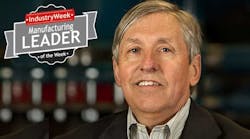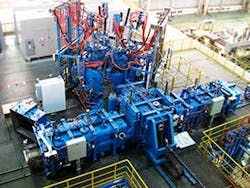Running his own company is "a lot of fun," says Jim Goltz, the president of Retech Systems, based in Ukiah, Calif., about 2 hours north of San Francisco. But he admits, “In our view, we’re a relatively small company with big company problems."
Retech manufactures vacuum furnaces for processing reactive metals, such as titanium, rare earth metals and nickel alloys used in jet engine turbine blades and industrial gas turbines, that can’t be exposed to oxygen. Retech is a leader or major competitor in many of the markets it serves.
The problems Goltz refers to don’t come from a lack of business but from dealing with issues that large companies can dedicate a whole department to – issues such as complex contracts (sometimes 150 pages in length), foreign exchange rates, U.S. export controls, and risk and insurance matters.
Some of the challenges Retech faces are endemic to middle market companies, says Derrick Ragland, executive vice president at HSBC Bank USA, which recently published the report, “Hidden Impact: The Vital Role of Mid-Market Enterprises.” He refers to these companies with $50 million to $500 million in sales as the “forgotten middle child of the business world.” They don’t have the influence of bigger firms but they’re also too big to benefit from the incentives and support offered to small businesses.
However, Ragland points out that middle market companies are vital to the global economy. Nowhere is that more true than in the United States, where there are 55,700 such firms. Manufacturing is the third-largest component of the middle market, HSBC reports, with 7,500 companies and 3.3 million employees.
Goltz’s concerns about the complexity of international business don’t stem from a lack of experience. Before joining Retech, he was a vice president of finance for the Energy and Environment sector at Lockheed Martin. His responsibilities covered 11 operating units with $4 billion in sales and a staff of 1,500.
Retech was owned by Lockheed Martin. When the aerospace giant elected to get out of the business, Goltz decided it was his chance to become a “big fish in a small pond” and put together a management buyout of Retech.
Creating a More Flexible Company
The furnaces Retech builds are highly customized. “We rarely build exactly the same furnace twice,” says Goltz. The furnaces involve advanced technologies, primarily revolving around the furnace’s energy source, which may be an electron beam gun, plasma torches or inductive heating.
Retech’s furnaces range in size from models for laboratory work to large furnaces used for products ranging from aerospace components to piping for nuclear plants, desalinization plants and chemical facilities which require corrosion-resistant products.
Because its furnaces are customized to buyer’s specifications, delivery time can range from 8 or 9 months to 2 years. Installation and start-up periods can take another 6 months or more beyond the production time.
At the time of the buyout, the company manufactured virtually its entire product and produced about a third to a half of the volume it does now with 350 people. Today, Retech has 120 employees, divided roughly evenly among engineering, technical trades and administration and sales staff, and approximately $60 million in annual sales.
Goltz moved the company from a vertically integrated shop to one where about 10% of the manufacturing takes place in-house. The company now outsources much of its components through a global supply chain but has retained a 135,000 square foot manufacturing facility that includes a sophisticated machine shop and welding capability. Goltz said the company will do the manufacturing when it is working on a project with a very fast turnaround or when it is building a first–of-a-kind product that requires new engineering.
While Retech’s location in Mendocino County in northern California may be idyllic, Goltz says it is “the last place” you would choose if you were deciding now where to locate the business.
“We’re one of the only manufacturing facilities for quite a distance,” he notes. “Getting people with these engineering and technical skills to a rural, agricultural area is a bit of challenge.”
Part of that challenge relates to housing prices in the area. When he talks to Midwesterners, they’ll tell him they can find a four-bedroom, three-bath house on a half acre for $225,000.
“They ask, ‘What will that buy me in Ukiah. ‘ The answer is, ‘A very nice trailer,’” he says.
But he points out, when Retech gets people to come to the area, they rarely lose them. “People love living here. It’s a beautiful place. The weather is great,” he says. And the location offers good access to shipping, with the port of Oakland less than 2 hours away.
Goltz says the company is always looking to add to its technical and sales staff. In the last 5 years, he says, the company has adopted a strategy of hiring graduates of California’s well-regarded university system. Two out of three of these young employees may leave the company as their lives and careers evolve, Goltz admits, but the hires Retech keeps “turn out to be excellent. You have to make that investment.”
Growing Around the World
“We do business around the world,” Goltz says, explaining that about half of the company’s sales are for export markets.
Retech’s export business also is picking up because it is part of SECO/Warwick, a group of companies headquartered in Poland. Retech became a wholly-owned subsidiary in 2011. SECO/Warwick sells its products in 45 countries and has facilities in Germany, Russia, India, China and Brazil as well as the U.S. and Poland. Goltz says the company’s strategy is to take their technology, adopt it for these markets and build it locally.
“The people in India want a product built preferably in India so they get service and parts,” he observes.
As an exporter selling custom equipment outside the U.S., Goltz says the Export-Import Bank of the U.S. has been vital to its efforts to obtain financing. Goltz says his “eyes glaze over” when he reads the comments of bank critics who say businesses such as Retech can get support elsewhere.
“In spite of what some people in Congress say, I have no idea what we are going to do if they do away with the Export-Import Bank. We have a very good relationship with them, have had for the past decade, through HSBC,” Goltz says.
In January, Retech posted a note on its website saying that “2015 is starting off to look like an eventful year for Retech.” Asked about that optimistic message, Goltz explains that the last 12 to 18 months was slow, in part because Boeing and Aerobus were working through production issues with the 787 and A350. Large infrastructure projects for chemical plants and nuclear plants were also dragging.
But he says with the economy improving, 2015 is promising a pickup in business. Companies are looking ahead to 2017 and 2018, considering increased demands and placing orders for furnaces.
“We tend to be driven by a few large projects. Big furnaces can be upward of $20 million,” he says. “A couple large projects can really drive our results for any given year.”
Aerospace isn’t the only demand area. Goltz noted that one of Retech’s lines is building equipment for making metal powders that are used in the booming additive manufacturing area. “We are seeing that area about to grow significantly over the next year or two,” Goltz predicts. “The techniques we use for casting and refining these reactive metals have a lot of applications to the same problems you have when you try to make powder.”
Another example that offers growth for Retech is silicon for solar applications. “We are doing some work in that area,” he notes, along with others he did not want to disclose. These efforts are all part of an effort to diversify the company from its original focus on processing titanium.
Perhaps because he spent nearly 30 years in a large corporation, Goltz says his management philosophy is “to get good people and give them authority and responsibility to go out and perform without being burdened by all the structure and reporting.”
Being tuned into the needs of his customers and encouraging speed and flexibility, he notes, is a competitive advantage for his middle-market company.
“The beauty of being in this situation is the flexibility you have to change on a dime when things appear to be a little bit different than you anticipated a year or two ago,” says Goltz. In his old job, he says, it might have taken years to change directions. Now, he says, “Here we can do it in a week.”




